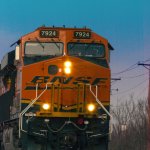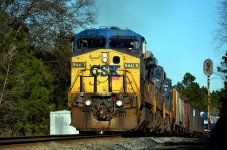OK, remember, I am a newbie and learning. So I have been trying to go out and shoot as much as possible, so yesterday, my son and I went out to shoot some train track shots, they came out pretty good, but to my joy a train came by. It was a bright sunny day about 2 in the afternoon. The sun was high over my left shoulder, but my shots thank goodness in raw mode came out extremely dark! I had to really use the exposer slide when processing them in Photoshop. I am assuming that the train lights fooled my metering system and I should have taken control of the metering on these shots? If that is the case what metering should I have used and it was moving pretty quick, so I did not have time for a test shot, so how would I have known?
Thanks
D7100
Nikon 55-200mm
F20
Shutter: 1/400
ISO 100


Thanks
D7100
Nikon 55-200mm
F20
Shutter: 1/400
ISO 100



